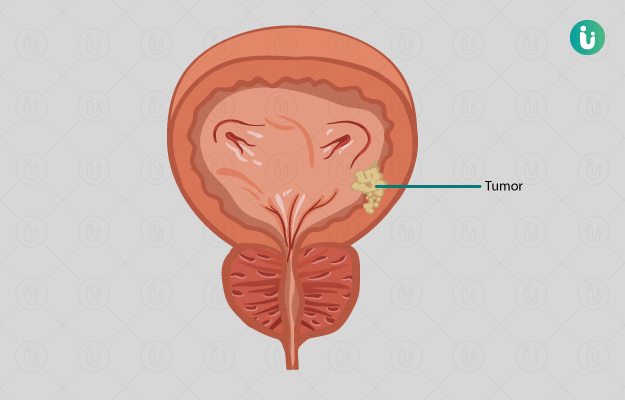What is bladder cancer?
Bladder cancer is a common type of cancer seen in adults in the age group of 50 to 70 years. It ranks sixth amongst the most commonly occurring cancers in India. Bladder cancer is an abnormal growth of cells in the bladder lining. Approximately 15% of cancer cases occurring due to tobacco use are of bladder cancer. Removal of tumour from the bladder (transurethral resection of bladder tumour or TURBT) results in improvement in a majority of the bladder cancer cases. However, cancer recurs in more than 50% of cases, and in 20% of these, cancer spreads into the tissue surrounding the bladder (muscle-invasive bladder cancer). TURBT, chemotherapy and radiation therapy are the most commonly used treatment options depending on the grade of cancer.
What are its main signs and symptoms?
Bladder cancer is suspected in the presence of the following signs and symptoms:
- Haematuria or blood in urine, usually not associated with pain. Urine appears rusty or bright red in colour
- Increase in the frequency of urination Read more: Frequent urination treatment
- Sudden urge to pass urine
- Pain or burning sensation while passing urine
- Back pain, bone pain, oedema or swelling of the legs occurs when cancer spreads beyond the urinary bladder
- Weight loss in the advanced stage of cancer
Other causes of haematuria (blood in the urine) include:
- Urinary tract infection
- Menstruation
- Kidney stone
- Sexual intercourse
- Blood-thinning medicines (anti-coagulants)
- Enlarged prostate gland
What are the main causes?
Causes attributed to the development of bladder cancer include:
- Tobacco consumption
- Exposure to chemicals like aniline dyes and benzidine, which is used in the manufacture of paints, textiles, rubber, plastics, etc.
- Radiotherapy used in the treatment of intestinal cancer
- Medicines used in chemotherapy
- A few other causes include infection of bladder (schistosomiasis), diabetes, chronic catheterisation and menopause before 45 years of age
How is it diagnosed and treated?
In addition to a detailed history and physical examination, diagnosis of bladder cancer is made on the basis of the following investigations:
- Cystoscopy is done to view the tumour inside the bladder.
- the tumorous tissue taken out during cystoscopy is examined under a microscope to identify the stage and grade of cancer.
- Computed tomography scan and magnetic resonance imaging give a detailed image of the tumour.
- Intravenous urogram takes an X-ray image of the bladder while the dye flows through the urinary tract to detect the tumour.
- Urine sample is examined under microscope to detect cancer cells in the urine.
- Tumour marker test (bladder tumour antigen) is done to detect proteins or antigens secreted by cancer cells.
Bladder cancer, that is limited to the innermost lining of the urinary bladder is called non–muscle-invasive bladder cancer, whereas cancer that spreads to the deeper layers of the bladder (through the muscle layer, fat and connective tissue) and to the other organs around the urinary bladder is called muscle-invasive bladder cancer. Grading helps in analysing the spread of cancer. High-grade cancer is more prone to spread compared to low-grade cancer.
Treatment depends on the stage and grade of bladder cancer. It generally includes:
- TURBT
- Surgery is done to remove the tumour when the cancer is limited to the superficial layer of the urinary bladder. Low-grade non–muscle-invasive cancers respond positively to this surgery.
- Chemotherapy: The chemotherapy drug is injected directly into the bladder after TURBT to prevent recurrence. Doctors advise chemotherapy in low to medium risk cancer depending on the stage of cancer.
- Radiation therapy: High-grade bladder cancers that have spread generally require radiation therapy in addition to chemotherapy.
- Immunotherapy: Some cases of early-stage cancer are also treated with a modified form of BCG vaccine after TURBT.
- A part or whole of the urinary bladder is removed surgically if cancer fails to respond to treatment with BCG.
(Consult a doctor with Doctor app)

 Doctors for Bladder Cancer
Doctors for Bladder Cancer  OTC Medicines for Bladder Cancer
OTC Medicines for Bladder Cancer



















